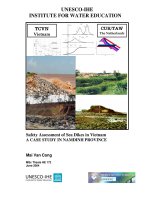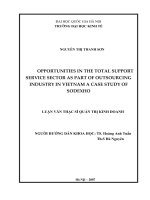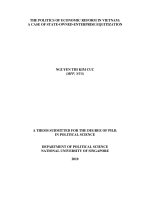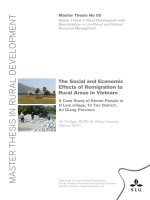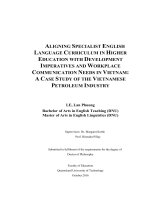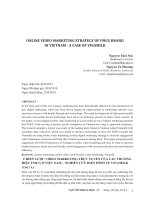Aligning specialist english language curriculum in higher education with development imperatives and workplace communication needs in vietnam a case study of the vietnamese petroleum industry
Bạn đang xem bản rút gọn của tài liệu. Xem và tải ngay bản đầy đủ của tài liệu tại đây (5.71 MB, 312 trang )
ALIGNING SPECIALIST ENGLISH
LANGUAGE CURRICULUM IN HIGHER
EDUCATION WITH DEVELOPMENT
IMPERATIVES AND WORKPLACE
COMMUNICATION NEEDS IN VIETNAM:
A CASE STUDY OF THE VIETNAMESE
PETROLEUM INDUSTRY
LE, Lan Phuong
Bachelor of Arts in English Teaching (DNU)
Master of Arts in English Linguistics (DNU)
Supervisors: Dr. Margaret Kettle
Prof. Hitendra Pillay
Submitted in fulfilment of the requirements for the degree of
Doctor of Philosophy
Faculty of Education
Queensland University of Technology
October 2016
Keywords
Workplace communication
Textual knowledge
Participant knowledge
Global, institutional and organisational knowledge
Social action knowledge
English for specific purpose curriculum
Aligning Specialist English Language Curriculum in Higher Education with Development Imperatives and
Workplace Communication Needs in Vietnam: A Case Study of the Vietnamese Petroleum Industry
i
Abstract
Globalisation, the opening of an Asian trading bloc in 2015 and the recent
Trans-Pacific Partnership Agreement are pushing Vietnam to focus heavily on
teaching and learning English for Specific Purposes (ESP) to support business and
industry. Designing ESP curricula, which are aligned with industry needs, is now an
urgent issue for Vietnam. It is especially important in the petroleum industry, which
involves many joint ventures with international companies and is considered vital to
Vietnam’s industrialisation and modernisation. While ESP has evolved to meet
specialist needs in many industry contexts, there are still few scholarly published
studies on reforming an English language curriculum in higher education, especially
for petroleum engineering to meet the demand in the changing labour market in
Vietnam. Therefore, the present study is a pioneer in this field.
The study aims to investigate to what extent the ESP curriculum in
Vietnamese universities is aligned with workplace communication needs.
Specifically, the alignment of the English for petroleum engineering (EPE)
curriculum at Nam Khue university (NKU) with the workplace communication needs
of two joint-venture petroleum companies in Vietnam was explored. In order to
achieve this research objective, the study was conducted in three phases based on
Huhta, Vogt, and Tulkki’s (2013) model of professional communication. The three
phases included (1) examining the kinds of knowledge required by the petroleum
engineers for their workplace communication in the two petroleum companies, (2)
investigating kinds of knowledge taught in the EPE curriculum at NKU to prepare
the EPE students for their future workplace communication and (3) identifying the
level of alignment between the university provision and the workplace demands.
The present study adopted a qualitative case study methodology to gain a
comprehensive picture of workplace communication needs in the two petroleum
companies and a holistic understanding of EPE provision at NKU. In the company
site, data was collected through document analysing, semi-structured interviews and
audio recordings of daily calls while the university data was gathered through
document reviewing, semi-structured interviews and classroom observations.
Aligning Specialist English Language Curriculum in Higher Education with Development Imperatives and
Workplace Communication Needs in Vietnam: A Case Study of the Vietnamese Petroleum Industry
ii
The study revealed some important findings. While the petroleum engineers
in the two petroleum companies used textual knowledge; participant knowledge;
global, institutional and organisational knowledge; and social action knowledge for
their workplace communication, the EPE curriculum at NKU focused on teaching
textual knowledge. This result indicates that the EPE provision at NKU was
misaligned with the workplace communication needs of the petroleum companies.
From a practical perspective, the study provides recommendations for a more
effective EPE curriculum and also practical implications for the employers in the
petroleum companies in their recruiting and training of petroleum engineers. The
study provides a new theoretical perspective to evolving workplace contexts in ESP
curricula in Vietnam. The research contributes to improving ESP curriculum design
and implementation in Vietnamese universities in order (1) to increase the
effectiveness of the teaching and learning of ESP in Vietnamese higher education
institutions and (2) to provide graduates with workplace communication competence
to improve their employability prospects and their effectiveness in industries.
Aligning Specialist English Language Curriculum in Higher Education with Development Imperatives and
Workplace Communication Needs in Vietnam: A Case Study of the Vietnamese Petroleum Industry
iii
Table of Contents
Keywords ...................................................................................................................................i
Abstract .................................................................................................................................... ii
Table of Contents .....................................................................................................................iv
List of Figures ....................................................................................................................... viii
List of Tables ............................................................................................................................. x
List of Excerpts ........................................................................................................................xi
List of Abbreviations ............................................................................................................. xiii
Statement of Original Authorship ..........................................................................................xiv
Acknowledgements ................................................................................................................. xv
Chapter 1:
Introduction ...................................................................................... 1
1.1 Introduction ...................................................................................................................... 1
1.2 Background of the study .................................................................................................. 2
1.2.1 Globalisation and higher education reform .......................................................... 2
1.2.2 Globalisation and English language education ..................................................... 3
1.2.3 An overview of the higher education system in Vietnam .................................... 5
1.2.4 Higher education reform in Vietnam .................................................................... 6
1.2.5 Foreign language education policy in Vietnam .................................................... 7
1.2.6 National Foreign Languages 2020 Project (NFL 2020) ..................................... 10
1.2.7 Current practice of ESP teaching and learning in Vietnamese higher
education ............................................................................................................. 11
1.3 Context of the petroleum industry in Vietnam .............................................................. 13
1.3.1 An overview of the Vietnamese petroleum industry .......................................... 13
1.3.2 Development of workforce for the petroleum industry ...................................... 16
1.4 Purposes of the Study .................................................................................................... 19
1.5 Significance of the Study ............................................................................................... 20
1.6 Scope of the Study ......................................................................................................... 21
1.7 Summary of the chapter and structure of the thesis ....................................................... 22
Chapter 2:
English for Specific Purposes ........................................................ 25
2.1 Introduction .................................................................................................................... 25
2.2 An overview of English for specific purposes ............................................................... 25
2.2.1 The origin of ESP ............................................................................................... 25
2.2.2 The development of ESP .................................................................................... 26
2.2.3 Understandings of ESP ....................................................................................... 28
2.2.4 Types of ESP learner’s needs ............................................................................. 30
2.2.5 Approaches to needs analysis ............................................................................. 39
2.2.6 Forms of ESP teaching ....................................................................................... 48
2.2.7 Problems in ESP ................................................................................................. 57
2.3 Summary of the chapter ................................................................................................. 64
Chapter 3:
Conceptual Framework of the Study ........................................... 65
Aligning Specialist English Language Curriculum in Higher Education with Development Imperatives and
Workplace Communication Needs in Vietnam: A Case Study of the Vietnamese Petroleum Industry
iv
3.1 Introduction ................................................................................................................... 65
3.2 Language learning ......................................................................................................... 67
3.2.1 Language, language teaching and language learning ......................................... 67
3.2.2 Communicative competence .............................................................................. 69
3.2.3 Communicative language teaching .................................................................... 71
3.3 Workplace learning ....................................................................................................... 72
3.4 Workplace communication............................................................................................ 74
3.4.1 Communication .................................................................................................. 74
3.4.2 Workplace communication ................................................................................ 75
3.4.3 Kinds of knowledge needed for workplace communication .............................. 80
3.5 Curriculum development ............................................................................................... 93
3.6 Summary of the chapter ................................................................................................ 97
Chapter 4:
Research Methodology ................................................................... 99
4.1 Introduction ................................................................................................................... 99
4.2 Research design overview ............................................................................................. 99
4.3 Qualitative paradigm ................................................................................................... 101
4.4 Case study.................................................................................................................... 103
4.5 Site and participant selection ....................................................................................... 104
4.5.1 Workplace sites ................................................................................................ 104
4.5.2 The university site ............................................................................................ 107
4.6 Data collection ............................................................................................................. 110
4.6.1 Interviews ......................................................................................................... 111
4.6.2 Classroom observations ................................................................................... 117
4.6.3 Document reviewing ........................................................................................ 118
4.6.4 Audio recordings of daily calls ........................................................................ 120
4.7 Data analysis and interpretation .................................................................................. 121
4.7.1 Organising and familiarising ............................................................................ 122
4.7.2 Coding and reducing ........................................................................................ 124
4.7.3 Interpreting and representing ........................................................................... 129
4.7.4 Corpus analysis ................................................................................................ 129
4.8 Ethical issues ............................................................................................................... 131
4.9 Trustworthiness ........................................................................................................... 133
4.10 Summary of the chapter.............................................................................................. 134
Chapter 5:
Kinds of Knowledge Required for Workplace Communication in
Two Petroleum Companies in Vietnam ................................................................ 137
5.1 Introduction ................................................................................................................. 137
5.2 Textual knowledge required for workplace communication in two petroleum
companies in Vietnam .......................................................................................................... 138
5.2.1 Communication situations required for workplace communication in two
petroleum companies in Vietnam..................................................................... 138
5.2.2 Genres required for workplace communication in two petroleum
companies in Vietnam ...................................................................................... 140
5.2.3 Texts required for workplace communication in two petroleum
companies in Vietnam ...................................................................................... 142
Aligning Specialist English Language Curriculum in Higher Education with Development Imperatives and
Workplace Communication Needs in Vietnam: A Case Study of the Vietnamese Petroleum Industry
v
5.3 Participant knowledge required for workplace communication in two petroleum
companies in Vietnam ........................................................................................................... 158
5.4 Global, institutional and organisational knowledge required for workplace
communication in two petroleum companies in Vietnam ..................................................... 163
5.5 Social action knowledge required for workplace communication in two petroleum
companies in Vietnam ........................................................................................................... 168
5.6 Discussion and summary of the chapter ...................................................................... 172
Chapter 6:
Kinds of Knowledge Taught in the English for Petroleum
Engineering Curriculum at Nam Khue University............................................. 177
6.1 Introduction .................................................................................................................. 177
6.2 Textual knowledge taught in the EPE curriculum at NKU ......................................... 178
6.2.1 Communication situations taught in the EPE curriculum at NKU ................... 178
6.2.2 Genres taught in the EPE curriculum at NKU .................................................. 184
6.2.3 Texts taught in the EPE curriculum at NKU .................................................... 186
6.3 Participant knowledge taught in the EPE curriculum at NKU .................................... 192
6.4 Global, organisational, and institutional knowledge taught in the EPE curriculum at
NKU 193
6.5 Social cction knowledge taught in the EPE curriculum at NKU ................................. 196
6.6 Discussion and Summary of the chapter...................................................................... 199
Chapter 7:
Alignment between the Workplace Communication Needs and
the English for Petroleum Engineering Curriculum .......................................... 201
7.1 Introduction .................................................................................................................. 201
7.2 Textual knowledge ....................................................................................................... 202
7.2.1 Communication situations ................................................................................ 202
7.2.2 Genres ............................................................................................................... 204
7.2.3 Texts ................................................................................................................. 205
7.3 Participant knowledge, global, institutional and organisational knowledge and social
action knowledge .................................................................................................................. 208
7.4 Summary of the chapter ............................................................................................... 211
Chapter 8:
Contributions and Conclusions ................................................... 213
8.1 Introduction .................................................................................................................. 213
8.2 Theoretical contributions ............................................................................................. 213
8.3 Practical contributions ................................................................................................. 215
8.3.1 Practical contributions for the EPE curriculum at NKU .................................. 215
8.3.2 Practical contributions for the two petroleum companies in Vietnam ............. 224
8.4 Pedagogical contributions ............................................................................................ 225
8.5 Limitations and directions for further research ............................................................ 225
8.6 Conclusion ................................................................................................................... 226
References ............................................................................................................... 228
Appendices .............................................................................................................. 257
Appendix A: Interview protocol for company participants ........................................ 257
Appendix B: Classroom Observations ........................................................................ 260
Appendix C: Ethics: Example of participant information and consent forms ............ 261
Aligning Specialist English Language Curriculum in Higher Education with Development Imperatives and
Workplace Communication Needs in Vietnam: A Case Study of the Vietnamese Petroleum Industry
vi
Appendix D: Language and communication policy in Company 1 ........................... 265
Appendix E: Common word types in emails in Company 1 and Company 2 ............ 267
Appendix F: Common word types in daily calls in Company 1 and Company 2 ...... 271
Appendix G: Daily report - Company 1 ..................................................................... 274
Appendix H: Daily report Company 2 ....................................................................... 276
Appendix I: Example of reading task in the EPE course ........................................... 278
Appendix J: Example of translation task in the EPE course ...................................... 281
Appendix K: Example of describing a process .......................................................... 287
Appendix L: Example of end-term tests in the EPE course ....................................... 291
Appendix M: Outline of the EPE course .................................................................... 294
Aligning Specialist English Language Curriculum in Higher Education with Development Imperatives and
Workplace Communication Needs in Vietnam: A Case Study of the Vietnamese Petroleum Industry
vii
List of Figures
Figure 1.1. Kachru’s Circles of English. ..................................................................... 4
Figure 1.2. Core business sectors of PVN (PVN, 2013a). ........................................ 13
Figure 1.3. Summary of Vietnamese oil/gas production (PVN, 2013a). .................. 16
Figure 2.1. Classification of ESP by Huhta et al. (2013, p. 37). ............................... 27
Figure 2.2. Learner’s needs classification based on P. C. Robinson (1991). ............ 32
Figure 3.1. Conceptual framework of the study. ....................................................... 66
Figure 3.2. Canale and Swain’s (1981) model of communicative competence. ....... 70
Figure 3.3. Huhta et al.’s (2013) model of professional communication.
Retrieved from
/>Reprinted with permission. .......................................................................... 79
Figure 3.4. Model of textual knowledge, extracted from Huhta et al.’s (2013)
model of professional communication......................................................... 80
Figure 3.5. Model of participant knowledge extracted from Huhta et al.’s
(2013) model of professional communication. ............................................ 85
Figure 3.6. Model of global, institutional and organisational knowledge
extracted from Huhta et al.’s (2013) model of professional
communication. ........................................................................................... 87
Figure 3.7. Model of social action knowledge extracted from Huhta et al.’s
(2013) model of professional communication. ............................................ 89
Figure 3.8. Activities for professional communication suggested by Huhta et
al. (2013). ..................................................................................................... 96
Figure 3.9. Dimensions of a workplace communication curriculum. ....................... 96
Figure 4.1. Research design of the study. ................................................................ 100
Figure 4.2. Summary of all the data sets in the study.............................................. 121
Figure 4.3. Steps of data analysis in the study. ....................................................... 131
Figure 5.1. Textual knowledge used in the two petroleum companies. .................. 138
Figure 5.2. Participant knowledge used in the two petroleum companies. ............. 158
Figure 5.3. Global, institutional and organisational knowledge used in the two
petroleum companies. ................................................................................ 164
Figure 5.4. Social action knowledge used in the two petroleum companies. .......... 169
Figure 5.5. Kinds of knowledge required for workplace communication in the
two petroleum companies. ......................................................................... 174
Figure 6.1. Textual knowledge taught in the EPE curriculum at NKU. .................. 178
Figure 6.2. Example of teaching vocabulary in the EPE curriculum at NKU
(NKU-ClassObservation 2). ...................................................................... 190
Aligning Specialist English Language Curriculum in Higher Education with Development Imperatives and
Workplace Communication Needs in Vietnam: A Case Study of the Vietnamese Petroleum Industry
viii
Figure 6.3. Participant knowledge taught in the EPE curriculum at NKU. ............. 192
Figure 6.4. Global, institutional and organisational knowledge taught in the
EPE curriculum at NKU. ............................................................................ 193
Figure 6.5. Social action knowledge taught in the EPE curriculum at NKU. .......... 196
Figure 6.6. Kinds of knowledge taught in the EPE curriculum at NKU .................. 200
Figure 8.1. Model of workplace communication (developed from Huhta et al.’s
(2013) model of professional communication). ......................................... 214
Figure 8.2. Recommendations for the EPE curriculum............................................ 216
Aligning Specialist English Language Curriculum in Higher Education with Development Imperatives and
Workplace Communication Needs in Vietnam: A Case Study of the Vietnamese Petroleum Industry
ix
List of Tables
Table 1.1 Institutions with petroleum engineering education run by PVN................ 18
Table 1.2 Institutions with petroleum engineering education run by MOET ............ 19
Table 2.1 The Prolang list of language and communication situations in
industry and business (Adapted from Huhta (1999, p. 176)) .................. 33
Table 3.1 An overview of language theories (Lavadenz, 2011, p. 21) ....................... 67
Table 4.1 Research sites and participants of the study ............................................ 109
Table 4.2 Summary of data collection methods and participants ............................ 110
Table 4.3 Documents collected from the company site and the university site ....... 120
Table 4.4 Translation conventions used in interviews, audio recordings of daily
calls and classroom observations .............................................................. 123
Table 4.5 Research participants of the study ........................................................... 123
Table 4.6 A priori codes for thematic analysis (Workplace data) ........................... 126
Table 4.7 A Priori Codes for Thematic Analysis (University data) ......................... 127
Table 4.8 Data coding example ............................................................................... 128
Table 5.1 Language/communication situations in two petroleum companies in
Vietnam ...................................................................................................... 139
Table 5.2 Dominant communication situations and genres in two petroleum
companies in Vietnam ................................................................................ 141
Table 5.3 Percentages of different vocabulary types in emails in Company 1
and Company 2 .......................................................................................... 150
Table 5.4 Percentages of different vocabulary types in daily calls in Company
1 and Company 2 ....................................................................................... 151
Table 5.5 Technical words in emails and daily calls in Company 1 and
Company 2 ................................................................................................. 153
Aligning Specialist English Language Curriculum in Higher Education with Development Imperatives and
Workplace Communication Needs in Vietnam: A Case Study of the Vietnamese Petroleum Industry
x
List of Excerpts
Excerpt 5.1. Sample of grammatical mistakes in emails in Company 1 (CO1Email 50). ................................................................................................... 142
Excerpt 5.2. Example of grammatical mistakes in emails in Company 2 (CO2Email 1&2). ................................................................................................ 143
Excerpt 5.3. Example of grammatical mistakes in daily calls in Company 1
(CO1-Call 2). .............................................................................................. 144
Excerpt 5.4. Example of grammatical mistakes in daily calls in Company 2
(CO2-Call 5). .............................................................................................. 144
Excerpt 5.5. Example of word types in an email (CO2-Email 1). ............................ 152
Excerpt 5.6. Example of vocabulary mistakes in daily calls in Company 2
(CO2-Call 1). .............................................................................................. 155
Excerpt 5.7. Example of vocabulary mistakes in emails in Company 2 (CO2Email 9). ..................................................................................................... 155
Excerpt 5.8. Example of using participant knowledge in emails in Company 2
(CO2-Email 1). ........................................................................................... 158
Excerpt 5.9. Example of using participant knowledge in emails in Company 1
(CO1-Email3). ............................................................................................ 159
Excerpt 5.10. Example of using participant knowledge in daily calls in
Company 1 (CO1-Call 4). .......................................................................... 160
Excerpt 5.11. Example of using participant knowledge in daily calls in
Company 1 (CO1-Call 3). .......................................................................... 161
Excerpt 5.12. Example of using participant knowledge in daily calls in
Company 2 (CO2-Call 1). .......................................................................... 162
Excerpt 5.13. Example of global, institutional and organisational knowledge in
Company 2 (CO2-Email 56). ...................................................................... 166
Excerpt 5.14. Example of global, institutional and organisational knowledge in
emails in Company 1 (CO1-Email 4). ........................................................ 167
Excerpt 5.15. Example of social action knowledge used in daily calls in
Company 2 (CO2-Call 4). .......................................................................... 171
Excerpt 6.1. An excerpt of a reading task in the EPE curriculum (NKUClassObservation 1). .................................................................................. 181
Excerpt 6.2. An extract from a translation task in the EPE curriculum (NKUHandout 4). ................................................................................................. 182
Excerpt 6.3. Example of a writing-essay task in the EPE curriculum (NKUHandout 6). ................................................................................................. 185
Excerpt 6.4. An excerpt from teaching vocabulary in the EPE curriculum
(NKU-ClassObservation 2). ....................................................................... 190
Aligning Specialist English Language Curriculum in Higher Education with Development Imperatives and
Workplace Communication Needs in Vietnam: A Case Study of the Vietnamese Petroleum Industry
xi
Excerpt 6.5. Example of teaching field knowledge in the EPE curriculum at
NKU (NKU-ClassObservation 3). ............................................................. 194
Aligning Specialist English Language Curriculum in Higher Education with Development Imperatives and
Workplace Communication Needs in Vietnam: A Case Study of the Vietnamese Petroleum Industry
xii
List of Abbreviations
ESP
English for Specific Purposes
EPE
English for Petroleum Engineering
ELF
English as a Lingua Franca
CLIL
Content and Language Integrated Learning
CBI
Context-Based Instruction
TLI
Target Language Immersion
HERA
Higher Education Reform Agenda
MOET
Vietnamese Government Ministry of Education and Training
NFL 2020
National Foreign Languages 2020 Project
ELP
English Language Proficiency
PVN
Vietnam National Petroleum Group
PE
Petroleum Engineer
ELC
English Language Curriculum
TPP
Trans-Pacific Partnership Agreement
ASEAN
Association of Southeast Asian Nations
TSNA
Target situation needs analysis
CLT
Communicative language teaching
Aligning Specialist English Language Curriculum in Higher Education with Development Imperatives and
Workplace Communication Needs in Vietnam: A Case Study of the Vietnamese Petroleum Industry
xiii
Statement of Original Authorship
The work contained in this thesis has not been previously submitted to meet
requirements for an award at this or any other higher education institution. To the
best of my knowledge and belief, the thesis contains no material previously
published or written by another person except where due reference is made.
Signature:
_________________________
Date:
_______13/02/2017___________
Aligning Specialist English Language Curriculum in Higher Education with Development Imperatives and
Workplace Communication Needs in Vietnam: A Case Study of the Vietnamese Petroleum Industry
xiv
Acknowledgements
My study at the Queensland University of Technology over the last three
years could not have been accomplished without contributions from a large number
of people. First of all, I would like to acknowledge the precious work of my Principal
Supervisor, Dr Margaret Kettle, and my Associate Supervisor, Professor Hitendra
Pillay. I feel fortunate and honoured to work with such respected academics, and I
am indebted to them for all what they have contributed towards this project.
I would like to express my gratitude to the staff at the School of Cultural and
Professional Learning for providing a stimulating, friendly, and professional research
and study environment. My special thanks also go to Adjunct Professor Yoni Ryan,
Dr Emma Caukill and Dr Martin Reese at the Student Learning Support Service, and
Dr Michelle Dicinoski for their inputs which helped make this piece of writing more
coherent and cohesive and for their special interest in my research topic.
I also thank my previous boss, Dr Le Nguyen for her encouragement and
critical advice and my close friends Quynh Anh Nguyen, Dung Tran, Linh Tran and
Minh Tran for their support and friendship which have made my time in Brisbane
full of beautiful and unforgettable memories. Additionally, my dearest family have
supported and encouraged me in very special ways throughout this project.
Especially, my precious husband Tuan Tran who made my dream of undertaking a
PhD degree abroad come true: continuously trusting, inspiring and encouraging me
during my research journey. My thank goes to all my younger sisters and brothers
Nam Tran Le, Huy Nguyen, Khanh Le and Trinh Truong for their support, patience
and unconditional love and to my precious daughter, Nam Khue Tran for
understanding and loving me.
Last but not least, I would like to thank the joint scholarship between
Vietnamese government and Queensland University of Technology for generous
financial support during my three-year study in Australia.
.
Aligning Specialist English Language Curriculum in Higher Education with Development Imperatives and
Workplace Communication Needs in Vietnam: A Case Study of the Vietnamese Petroleum Industry
xv
Chapter 1: Introduction
1.1
INTRODUCTION
This thesis reports on a study investigating the alignment between English for
Specific Purposes (ESP) education and workplace communication. The specific case
being investigated is the English for petroleum engineering (EPE) curriculum at Nam
Khue University (NKU) in Vietnam and its alignment with the workplace
communication needs of petroleum engineers in two joint-venture petroleum
companies in the southern area of the country. The study utilised Huhta, Vogt and
Tulkki’s (2013) model of professional communication and was guided by the
overarching research question: “How does the English for petroleum engineering
curriculum at Nam Khue University align with the workplace communication needs
of the petroleum engineers in two joint-venture petroleum companies in Vietnam?”
The findings of the study make significant theoretical, practical and pedagogical
contributions to ESP research and teaching: (1) they offer a solution to ongoing
issues related to the disconnect between English for specific purposes (ESP) courses
and workplace communication needs; (2) they provide a means of improving ESP
teaching and learning in Vietnam; and (3) they contribute significantly to the
processes instituted by Vietnam to enhance industrialisation, modernisation and
integration into regional and global economies. While the study was contextualised
in the social, economic, historical and educational particularities of Vietnam, the
prevalence of ESP training means that the study has relevance to other countries,
especially those also using English as part of their program of modernisation.
This introductory chapter outlines important background to the study with
regard to globalisation and its influence on higher education reform and English
language education in the world and in Vietnam. It also presents the current practice
of English learning and teaching, especially ESP in Vietnamese higher education
(Section 1.2). It then describes the Vietnamese petroleum industry, which is the main
focus of the study (Section 1.3). The chapter also outlines the research objectives
(Section 1.4), significance (Section 1.5) and scope of this study (Section 1.6)..
Chapter 1: Introduction
1
Finally, a summary of the present chapter and an overview of the subsequent
chapters are presented in Section 1.7.
1.2
BACKGROUND OF THE STUDY
1.2.1 Globalisation and higher education reform
Globalisation is defined as a universal practice in which “people trade
products and services, travel, and communicate across international borders” (Lam,
2011, p. 22). In the era of globalisation, many countries, especially developing
countries, have faced “a global skill race” (G. Brown, 2008, p. 4). As described by P.
Brown, Lauder, and Ashton (2008), in this race, “the more skilled the workforce, the
more competitive the economy” (p.16). To have high-value and high-skill
economies, which most countries all over the world want, a well-educated workforce
is crucial. The countries with an education system that can supply the required
knowledge and skills have more chances of attracting foreign companies for
investment and taking a more important role in international affairs. Therefore,
education, especially higher education, is also affected in the era of globalisation and
knowledge-based economy “in which knowledge is the main determinant of
economic competitiveness” (Shin & Harman, 2009, p. 2).
In response to this increasing effect, governments and their educational
institutions have launched new educational policies to meet the challenge of
globalisation (Rizvi & Lingard, 2010; Rust & Kim, 2016). For example, the USA,
Britain, Canada, New Zealand and Australia have had education reforms that are
continuously focused on globalisation (Mok & Lee, 2003). Like Western countries,
Asian societies have also developed education reform policies, especially higher
education reform, to be able to engage with the era of globalisation. According to
Mok (2003), a group of East Asian countries including South Korea, Taiwan, Hong
Kong, Singapore, and China have undertaken higher education reforms such as
comprehensively reviewing their higher education systems, introducing new
measures that allow universities more autonomy, reviewing curricula and testing
systems and “revamping the university admission mechanisms” (p. 207). Since 1987,
the Taiwanese government has been reviewing and reforming its higher education
system through internationalisation and introducing reform measures to improve its
training quality. In their higher education reform agenda, Singapore has two main
Chapter 1: Introduction
2
policies: widening postgraduate education and research at universities, and
restructuring undergraduate curricula to develop students’ creativity and thinking
skills (Mok & Lee, 2003). In 1999, Thailand launched the National Education Act to
reform higher education with the main goal of developing future citizens who
demonstrate traits of competence, virtue and happiness (Sangnapaboworn, 2003).
1.2.2 Globalisation and English language education
Embedded in this globalisation move is the important role of English
language. English is increasingly the common language for worldwide connection
and communication (Hamid, 2010; Hsieh, 2010; Nunan, 2003; Rubdy & Sacraceni,
2006). English is the common international language in academic, political,
economic, technological and scientific domains (Graddol, 1997; Rubdy & Sacraceni,
2006). It is considered a key to many doors for social, academic and professional
advancement. In other words, English works as a bridge in international cooperation
and affairs, and is understood by many governments to bring benefits in terms of
trade and development. Without English, it is difficult to connect countries and to
work with international investors, who are often from English-speaking countries. It
is clear that English plays an increasingly vital role in the time of globalisation.
English is such a crucial language that it is used and learnt worldwide. In
other words, the recent spread of English has occurred as a result of economic
globalisation. To describe the spread of English, Kachru (1985) developed the
Concentric model with three circles, each representing a different kind of English
use. The Inner Circle, in which English is used as a first language, includes countries
like the United States, the United Kingdom, Canada, Australia and New Zealand.
The Outer Circle, in which English functions as a second language, covers countries
such as Brunei, Malaysia, the Philippines and Singapore. The Expanding Circle, in
which English is used as a foreign language or a lingua franca, includes countries
such as Japan, Korea, China, Russia, Cambodia, Indonesia, Laos, Thailand and
Vietnam. According to Graddol (1997), the number of non-native English speakers
leaves the number of its native speakers far behind.
Chapter 1: Introduction
3
Figure 1.1. Kachru’s Circles of English.
Rubdy and Sacraceni (2006) also emphasise the increasingly important role
of English today as a lingua franca. English as a lingua franca (ELF) is used in
Europe, throughout India, Africa and Asia. The non-native English speakers in these
areas use English as a means to communicate with other non-native speakers of
English. It is not surprising that the Association of Southeast Asian Nations
(ASEAN) has chosen English as their sole official working language for group
meetings and negotiation among members (Kirkpatrick, 2012; Shimizu, 2011;
Wright, 2004). In Eastern Europe, English is chosen for internal communication
between Rumanians or Hungarians and the speakers of Slav languages (Wright,
2004).
Ability in English language is considered necessary for a nation’s
development and economic competiveness in an increasingly globalised world. Fully
aware of this issue, non-English-speaking countries have seen English as a vital
factor to be taken into account in their language policy. They have made great efforts
to improve the quality of English teaching and learning in their education systems
(Bamgboe, 2001; Chang, 2006; Hamid, 2010; N. Hornberger & Vaish, 2009;
Kirkgöz, 2009; Smotrova, 2009; Vaish, 2008).
It is clear that globalisation has impacted on higher education and English
language education in many countries. Vietnam, a developing Asian country, is not
an exception. The Vietnamese government has paid much attention to the reform of
the HE system and to the development of language policies, especially English
language policies, to meet the demands of globalisation (MOET, 2005, 2008), which
Chapter 1: Introduction
4
will be discussed in detail in the following sections. However, in order to have a deep
understanding of HE reforms in Vietnam, it is necessary to have an overview of the
Vietnamese HE system.
1.2.3 An overview of the higher education system in Vietnam
The Vietnamese HE system comprises four levels of training including
College, Undergraduate, Master and Doctorate. At the college level, students with
upper secondary education certificates study for two to three years, depending on the
discipline. Students with secondary vocational certificates spend one-and-a-half to
two years in the same discipline. At the undergraduate level, students with upper
secondary education certificates take programs that vary in length from four to six
years, depending on the discipline. Master level is a program of study that takes one
to two years for students with bachelor degrees. Doctoral level takes three to four
years for students with master degrees. In special cases, training duration may be
longer in accordance with the regulations of the Ministry of Education and Training
(World Bank, 2014).
In the national educational system, there is another system called continuing
education that runs parallel to full-time education. While working, people can
undertake continuing education to improve their knowledge, skills, and quality of
life, or to find jobs. The Vietnamese government has policies to encourage the
development of continuing education, education for all, and a learning society
(MOET, 2011; World Bank, 2014).
There are different types of educational institutions in the Vietnamese HE
system such as public, semi-public, people-founded and private institutions. Most
institutions belong to the Vietnamese Government Ministry of Education and
Training (MOET) and the provinces. Public institutions are established by the
government and receive funding for the infrastructure, facilities and operational
expenditures. The other ministries, such as the Ministries of Heavy Industry, Health,
Culture and Art, build semi-public institutions focusing on one discipline, called
mono-disciplinary institutions. People-established institutions are funded by the
communities for their infrastructure, facilities and operational needs, while private
institutions are funded by social, professional, or economic organisations, or by
individuals, for their infrastructure, facilities and operational needs. The government
supports public institutions to ensure that they are playing a key role in the national
Chapter 1: Introduction
5
education system. All educational institutions are academically managed by MOET
in terms of admissions, curricula, assessments and degree granting (FCI, 2014).
1.2.4 Higher education reform in Vietnam
With the introduction of the Renovation policy in 1986, Vietnam began to
step into the world’s economy and establish relationships with other countries,
especially in the West. Along with an open door policy and market-oriented reforms,
Vietnam has developed action plans and policies in many fields, including education
in recent years, to contribute to the economic and social development of the country
in the globalisation era. Globalisation has put enormous pressure on Vietnam’s
education system, especially higher education, to develop a more professional labour
force that can help Vietnam compete in the international market (Dan Anh, 2016;
Luu, 2006; MOET, 2005; MOLISA, 2016a, 2016c; T. A. Nguyen, 2009).
The government’s Higher Education Reform Agenda (HERA) signed in 2005
aims at evolving a modern higher education system that can meet the demand of the
nation’s industrialisation and modernisation, ensure integration into the global
economy and address people’s learning needs (MOET, 2005). With many specific
objectives set out in the HERA to be achieved by 2020, the Vietnamese government
pursued a comprehensive education reform to enhance educational development in
Vietnam, and to prepare highly qualified human resources for the country’s
international integration.
Among the other targets, the HERA stressed developing HE curricula that
focused on scientific research and had an occupation-application orientation and
suggested some solutions including:
Restructuring the curriculum frame; guaranteeing of the inter-
•
school level; resolving the relationship between the amount of
knowledge and the time allocation of general education and
professional education in order to enhance the effectiveness of
training courses.
Renewing syllabi, which are close to the practice of scientific
•
research and the technological and occupational development in the
society, to meet the requirements of economic and social
development of each sector and each area and to reach the advanced
level of the world.
Chapter 1: Introduction
6
Developing the learners’ potentiality in innovative research,
•
professional skills, capabilities of working in the community and
ability to start a new career. (MOET, 2005, p. 2)
In addition, a priority of the HERA was to build a more internationally
integrated higher education system including improvement in the teaching and
learning of foreign languages, especially English. The deficiency in graduates’
competence in foreign languages was an obstacle to global integration and the
process of improving Vietnamese HE’s quality (MOLISA, 2016a, 2016c; T. N.
Pham, 2010). Therefore, the HERA argued that more serious attention should be
given to the teaching and learning of foreign languages in Vietnamese universities.
The HERA aims of renovating curricula and improving the teaching and learning of
foreign languages (especially English) have most relevance to the present study.
1.2.5 Foreign language education policy in Vietnam
Foreign language education policy in Vietnam has been influenced by
political and economic changes, because “[t]he promotion of a particular foreign
language was decided by the powerful cooperation alliances Vietnam pursued” (H.
T. Do, 1996, p. 48). In other words, the language of a country which had political
cooperation with Vietnam was learnt in Vietnam.
During the Vietnamese War from 1954 to 1975, Vietnam was divided into
two separate parts: the communist North and the capitalist South (H. T. Do, 2006).
While Russian and Chinese were the main foreign languages in the North, French
and English dominated the foreign language scene in the South. After 1975, when
Vietnam had a close political, economic and educational relationship with the Soviet
Union, the MOET mandated Russian as the main foreign language to be taught at all
educational levels in Vietnam (H. T. Do, 1996). The targets set at high schools, for
example, were 60% studying Russian, 25% studying English and 15% studying
French (Denham, 1992). Russian aid in education also strengthened the spread of this
language. A large number of Vietnamese teachers and students at both undergraduate
and graduate levels were sent to the former Soviet Union for Russian studies (H. T.
Do, 1996). Russian became the dominant foreign language in this period of early
reunification (Wright, 2004).
Chapter 1: Introduction
7
